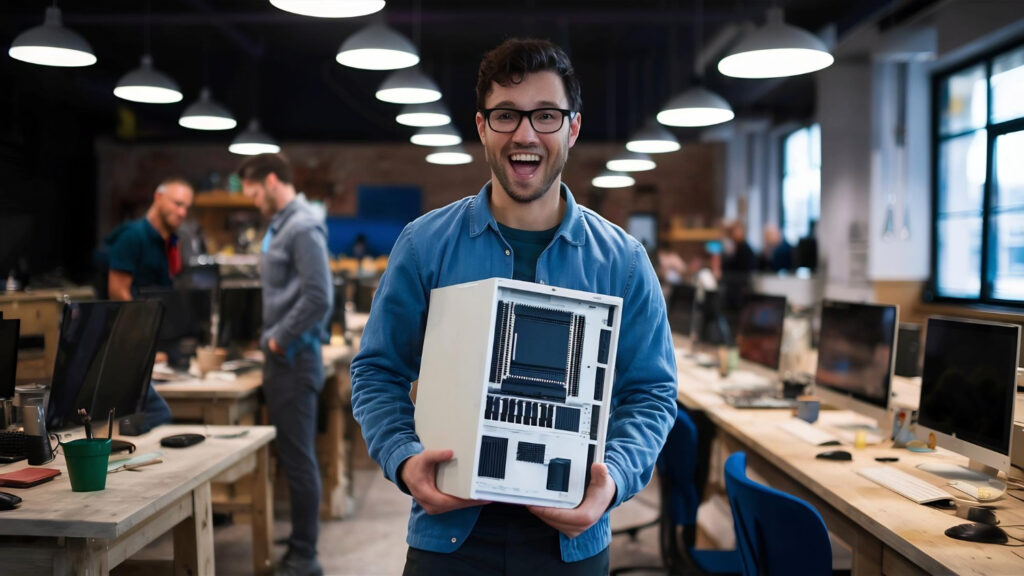
Ever had your laptop freeze during a client call? Or waited ages for a file to open?
These small delays add up, and usually, it’s the hardware slowing things down. As more teams shift to remote and hybrid work, having the right setup isn’t just helpful—it’s necessary. A slow machine, poor webcam, or tiny screen can seriously affect how your team works every day.
In fact, a 2023 Buffer report found that 52% of remote workers cited technical issues as a top challenge—highlighting just how critical proper hardware is.
Hardware decisions often get pushed aside, but they play a bigger role than most people realise. You don’t need the most expensive gear—just the right tools for how your team works.
Quick Hardware Selection Guide
✅ Key Considerations:
-
Match specs to actual software requirements
-
Prioritize portability for remote workers
-
Don’t sacrifice security features
-
Plan for 3-year lifespan, not immediate cost
❌ Common Mistakes:
-
Buying cheapest option without checking specs
-
Ignoring future growth or team expansion
-
Skipping warranties and support services
-
Forgetting hardware-level security features
💡 Bottom Line: Right hardware investment reduces downtime, boosts productivity, and supports your business growth for 3+ years.
Factors to Consider When Choosing Business Hardware
Choosing hardware isn’t just about specs—it’s about how your team works, what they struggle with, and what will actually help them get things done. Many businesses make the mistake of following trends or buying more than they need. Others go too cheap and face slowdowns, repairs, and downtime. Here are the most important things to think about before buying or upgrading any business hardware:
1. Understand what your team actually does all day
Before making a list of devices, take a closer look at your team’s actual workflow. What kind of apps do they use? Are they mostly on Excel and browsers, or using heavy software like video editors, design tools, or data platforms? The more demanding the tools, the better specs you’ll need, especially RAM, processor speed, and graphics support.
Don’t rely on assumptions; ask each team what tasks feel slow or frustrating. That’s where better hardware can make a big difference. Understanding how hardware and software work together helps you align purchasing decisions with actual business needs.
2. Don’t choose based on looks or brand
It’s easy to get pulled in by sleek designs or brand names, but don’t let aesthetics guide your decision. A stylish, thin laptop might overheat or slow down under basic pressure. A well-known brand doesn’t always offer better support or performance.
Focus instead on user reviews, after-sales service, durability, and how well the hardware handles real work. What matters most is whether it can keep up with your business needs every single day, not how good it looks on a desk.
3. Think beyond laptops, comfort matters more than you think
A good laptop won’t help much if your team is stuck squinting at a small screen or using a stiff keyboard all day. Invest in proper monitors, full-size keyboards, adjustable chairs, and good-quality mice. You don’t need a fancy setup, but ignoring physical comfort often leads to long-term problems like strain, burnout, and unhappy employees.
This ergonomic approach also supports managed IT services teams managing multiple workstations more effectively.
4. Buy for today, but plan for the next 3 year
A laptop that feels “good enough” today might struggle once you add more users, tools, or security updates. You don’t have to buy top-end devices, but avoid those with bare minimum specs. Choose something that will still perform well two or three years down the line. It saves money in the long run and avoids early replacements.
5. Match hardware with the software you rely on
Software and hardware go hand-in-hand. A business that uses CRM tools, video editing apps, or design software will need different hardware setups. Before buying anything, check the software’s minimum and recommended hardware requirements.
Some programs run fine on basic machines, while others need more RAM, better GPUs, or specific processors. Ignoring this can lead to slow loading times, crashes, or compatibility issues. Understanding hardware and software integration helps prevent these costly mistakes. Always match your hardware decisions to the actual tools your teams use every day, not general guesses.
6. Remote or hybrid setup? Hardware priorities change
If your team works from home, travels, or uses a mix of office and remote work, portability and battery life matter more. In-office desktops may offer better specs for less, but hybrid teams need light, reliable laptops with long battery backup, solid Wi-Fi, good webcams, and noise-cancelling headsets.
These things sound small, but they make remote work much smoother. Think of hardware as part of the overall setup, not just the machine, but how it helps people work from anywhere, without disruptions. This becomes even more critical when integrated with telecommunication services for seamless collaboration.
7. Don’t ignore storage, it fills up faster than you think
Storage often gets overlooked when choosing hardware. A 256GB SSD might seem fine initially, but files, updates, and media add up quickly, especially for design, video, or data-heavy teams. If your business handles massive files, opt for a minimum 512GB or 1TB of storage space, or supplement with external drives and cloud storage options.
Faster storage devices such as SSDs also cut down boot times and application launch times. It is not space alone that we need to consider here—it is speed and accessibility also.
8. Add security features to the mix
Security isn’t only about firewalls and passwords—your hardware can help protect sensitive information, too. Devices with fingerprint sensors, webcam covers, encrypted drives, or built-in privacy screens add an extra layer of safety. If a laptop is lost or stolen, hardware-level protections reduce the chances of data leaks.
It’s especially important if your team works remotely or travels often. These small features can prevent bigger problems and show clients you take data protection seriously. Learn more about comprehensive cybersecurity solutions to ensure complete protection beyond hardware alone.
Common Mistakes When Buying Business Hardware

Buying hardware isn’t just about picking a laptop off the shelf. Rushing the process or skipping key checks can cost you more in the long run. Here are some common mistakes businesses make, and how to avoid them.
1. Going for the cheapest option without checking specs
It’s tempting to save money by buying low-cost devices, but that often means outdated specs, poor build, or limited performance. These devices may work fine at first, but slow down quickly, affect productivity, or stop supporting new software updates. Instead of thinking only about cost, check if the hardware matches your team’s actual work. Spending slightly more on better machines now can help you avoid early replacements and support issues later.
2. Ignoring future growth or team size changes
Many businesses buy just enough for the current team without thinking about future hiring, remote teams, or software expansion. This leads to mismatched devices or extra spending later. It’s smarter to plan ahead. Even if you’re a team of five today, consider devices that can be easily added, upgraded, or reused when your team grows. A little foresight saves time, effort, and budget headaches down the road.
3. Skipping warranties or support services
Hardware issues are not just about repair costs—they cause downtime, missed deadlines, and frustrated employees. Yet, many businesses skip warranty upgrades or support services to cut costs.
A good warranty can give you quick replacements and peace of mind. Also, consider on-site support or quick-response service, especially for critical devices. It might cost a bit extra, but it saves you a lot when things go wrong. Partnering with an MSP can provide comprehensive hardware and support management.
4. Buying without involving the actual users
Decisions are often made by management or IT teams without checking what the actual users need. A designer might need a different setup than an accountant. If the device doesn’t support someone’s daily workflow, it causes delays and frustration. Before buying, talk to different teams, ask about their current pain points, software needs, and what’s slowing them down. Matching hardware to real usage is what makes the investment worth it.
5. Forgetting about security features
Devices without features like fingerprint login, TPM chips, or encryption support can become weak spots for your business. Especially with remote work, hardware security helps protect company data if a device is lost or stolen. Don’t assume all devices come with these features; check before you buy. Integrate hardware security into your broader network security audit strategy.
Hardware Investment ROI for Australian Businesses
Real-World Example: $50K Team (5 Employees)
Budget for 5 mid-range laptops + peripherals: $7,000
Productivity gains from proper hardware:
-
Reduced downtime: Save 2 hours/week per employee = 10 hours/week
-
Faster task completion: 15% speed improvement across workflows
-
Lower IT support costs: Fewer hardware failures & repairs
Annual Value:
- Productivity gain: 10 hours × 5 people × 52 weeks × $25/hour = $65,000
- IT cost savings: Estimated $3,000 (fewer repairs, support calls)
- Total annual benefit: $68,000
ROI: 871% in year one
Investing in proper hardware isn’t an expense—it’s a productivity multiplier that pays dividends through reduced downtime and improved operational efficiency.
Hardware Selection Checklist
Use this to evaluate any device before purchase:
☐ Matches actual software requirements (check minimum specs)
☐ Processor: Intel i5/AMD Ryzen 5 or better for most tasks
☐ RAM: Minimum 8GB (16GB recommended for multitasking)
☐ Storage: 512GB SSD minimum (avoid HDDs)
☐ Battery life: 8+ hours for remote workers
☐ Warranty: 3+ years with on-site support
☐ Security: Fingerprint reader, TPM 2.0, encryption support
☐ Build quality: Reviewed on durability & repairability
☐ Webcam & microphone: Quality matters for video calls
☐ Weight: Under 1.5kg for frequent travelers
Visit Our Hardware & Software Sale Page For Quick Solution
Frequently Asked Questions
Q1: What’s the minimum hardware spec for hybrid work?
8GB RAM, Intel i5/Ryzen 5 processor, 256GB SSD, good webcam, and a separate monitor. This setup supports most business apps, video conferencing, and multitasking without lag.
Q2: Is it better to buy laptops or desktops for a small business?
Desktops offer better specs for less money and better cooling. Laptops provide flexibility for remote/hybrid teams. Many Australian SMBs use a hybrid approach: desktops in-office, laptops for remote workers.
Q3: How often should we upgrade business hardware?
Plan for 3–4 year refresh cycles. Extend lifespan by adding RAM, upgrading SSDs, or replacing batteries. This helps manage costs while maintaining performance.
Q4: What security features should business hardware have?
Fingerprint login (biometric), TPM 2.0 chip, encrypted storage (SSD), and BIOS password protection. These reduce breach risk if a device is lost or stolen.
Q5: Can we mix different brands/models across the team?
Yes, but consistency simplifies IT support and reduces compatibility issues. If mixing brands, ensure all devices meet the same minimum specs and have compatible OS/security standards.
Q6: What’s included in a good hardware warranty?
On-site repair/replacement within 24–48 hours, accidental damage protection, and extended coverage (3+ years). Avoid mail-in-only warranties—downtime is costly for businesses.
Conclusion
Selecting the right hardware isn’t about purchasing the latest or most expensive gadgets. It’s about understanding what your team needs to work better each day, regardless of whether they are in the office or working remotely. A good hardware setup supports your business quietly in the background without constant issues or slowdowns.
Take the time to understand your daily tasks, future plans, and what your current setup lacks. Avoid rushing the decision just to save money or follow trends. Think long-term and aim for devices that match your pace and growth. When your hardware fits well with how your business works, everything else runs smoother.
If you’re unsure where to start, Hyetech can help assess your needs and recommend reliable solutions that grow with your team. Our experts ensure your hardware investments align with your business goals while maximizing productivity and security.
